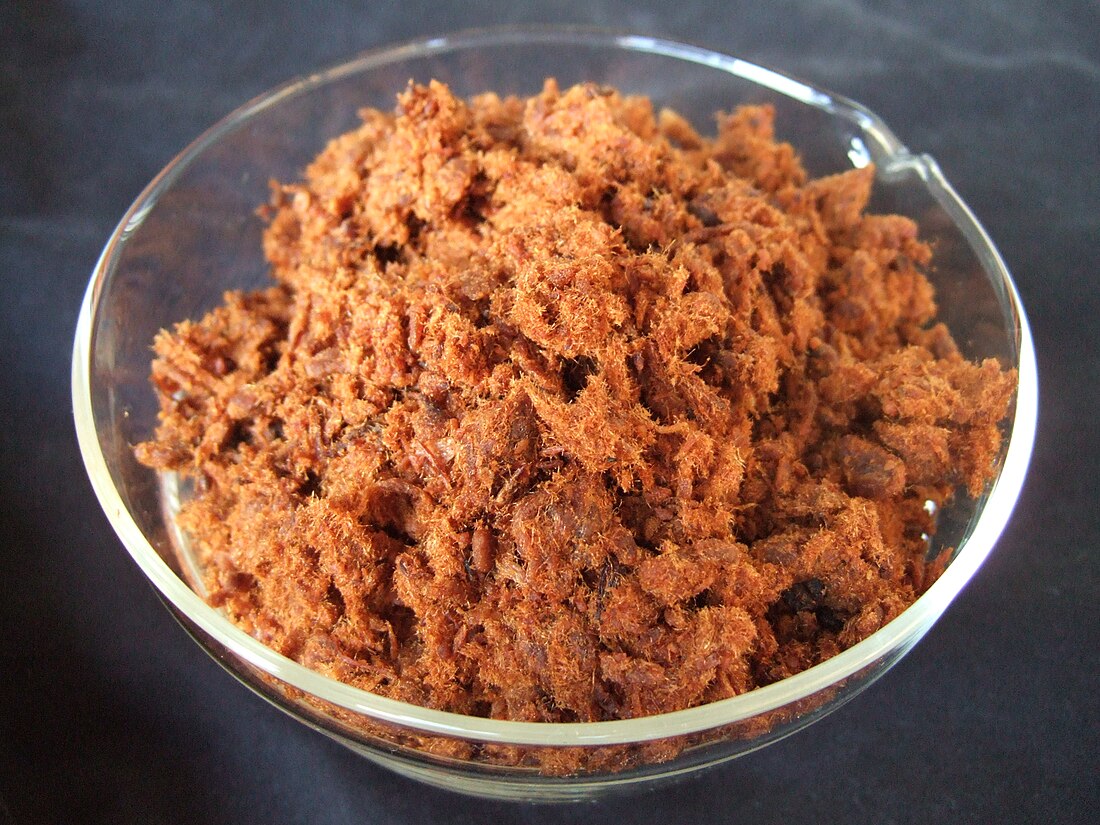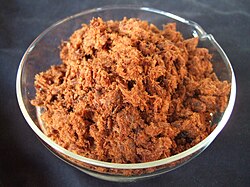Top Qs
Timeline
Chat
Perspective
Meat floss
Dried meat product from China From Wikipedia, the free encyclopedia
Remove ads
Meat floss, also known as yuk sung or rousong (Chinese: 肉鬆; pinyin: ròusōng; Jyutping: juk6 sung1 ; Mandarin Chinese: [ɻôʊsʊ́ŋ]), is a dried meat product of Chinese origin, with a light and fluffy texture similar to coarse cotton.[1][2] It is more commonly known as bak hu (Hokkien: 肉拊, Pe̍h-ōe-jī: bah-hú) in Hokkien-influenced regions, such as Southeast Asia and Taiwan.[3]
Remove ads
Production and styles
Meat floss is made by stewing finely cut pork, chicken or beef (though other meats may be used) in a sweetened mixture of soy sauce and various spices until individual muscle fibers can be easily torn apart. This happens when the water-insoluble collagen that holds the muscle fibers of the meat together has been converted into water-soluble gelatine.[4]
There are two styles of meat floss, which differ in whether oil is added during the last process of production. The Jiangsu style rousong is dry-cooked and the product is slightly chewy, while the Fujian style bak hu is fried with oil and the product is mildly crispy. Five kilograms (11 lb) of meat will usually yield about one kilogram (2.2 lb) of floss.[5]
Remove ads
Variations
Fish can also be made into floss (魚鬆; yú sōng), though initial stewing is not required due to the low collagen and elastin content of fish meat. Rabbit and duck floss can also be found in China.[6][7]
In Muslim-majority Indonesia and Malaysia, beef or chicken floss is the most popular variant, commonly called abon in Indonesian and serunding (also spelled serondeng) in Malay. In Malaysia, serunding is often served during Ramadan and Eid.[8]
- Fish floss is roasted to look similar to yuk sung.
- Beef floss vendor in Sulawesi, Indonesia
- Meat floss buns from Hong Kong
Remove ads
Health effects
A study has demonstrated a positive correlation between increased processing temperatures of meat floss and increased formation of heterocyclic aromatic amines (HAAs) within the meat. Up to seven different HAAs were found when meat floss was processed at 150 °C (302 °F).[9] HAAs are believed to promote the development of some cancers.[10]
See also
- Bakkwa – Salty-sweet dried meat product
- Čvarci – Southeastern European pork rind
- Dried shredded squid – Seafood product
- Katsuobushi – Dried, fermented, and smoked skipjack tuna
- Machaca – Mexican dish
- Pemmican – Food mix with long shelf life, sometimes used as survival food
- Pulled pork – Pork barbecue dish of the Southern United States
- Serundeng – Indonesian spiced grated coconut
 Food portal
Food portal
Remove ads
References
External links
Wikiwand - on
Seamless Wikipedia browsing. On steroids.
Remove ads




